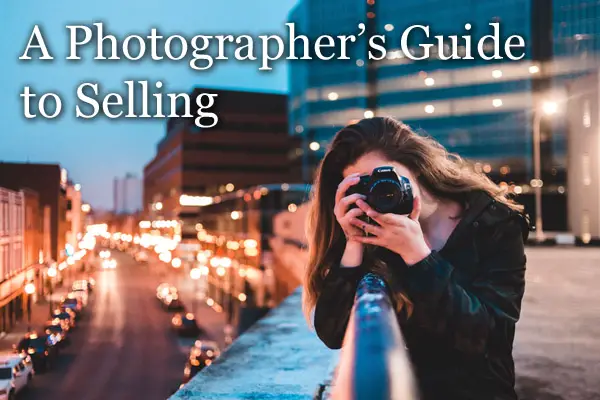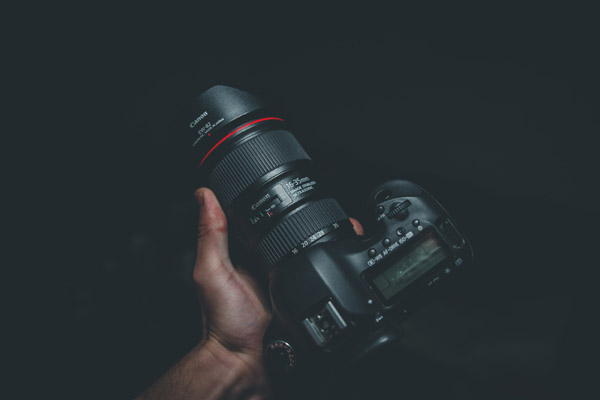Before you invest in an expensive degree in Photography or a related program, read this guide. There are countless methods for lucrative photography sales.

That’s because today, more people are purchasing art and printed photography than ever before. Continue reading for a comprehensive guide on selling photography.
A photographer’s guide to selling will cover:
- Why You Should Sell Your Photography
- What Types of Photography to Sell?
- Distinguishing Your Target Audience
- Finding the Right Printing Company
- How to Sell Photography
- Where Do You Sell Photography?
And much more.
There is a great deal of information to gather before you can create a successful photography business. Use this guide to understand how to market yourself in this rapidly-evolving industry.
A Photographer’s Guide to Selling
This guide will cover the following in-depth subjects related to profitability in your photography business:
- Why You Should Sell Your Photography
- What Types of Photography to Sell?
- Why You Need to Understand Who You’re Selling to
- Distinguishing Your Target Audience
- Finding the Right Printing Company
- Don’t Skimp on Quality Early-On (Repeat Business is Top Priority)
- How to Price Your Photography
- Questions to Ask Yourself
- Tips to Keep in Mind for Pricing
- Where Do You Sell Photography?
- Your Personal Website
- Third-Party Platforms
- Local Art Shows
- How to Sell Photography
- You’re Selling Art Now
- Sell an Experience
- Sell Exclusivity and Scarcity
- Show Them a Preview of the Art on Their Wall
- Give Them Options
- Final Tips for Creating a Lucrative Photography Business

Why You Should Sell Your Photography
We understand that it can be a vulnerable move to share this part of yourself. Just a few of the reasons why you should sell your photography images are:
- This is the best time in history to do so. Never before has the internet been so prevalent and powerful. Fifty years ago you could only sell art in-person, to your cousin, or family friend. Now you are literally able to reach the entire world, offering you a larger and clearer reach on the audience you are targeting.
- Once you get started, images can be printed into anything you can dream of:
- Mugs
- Wallpapers
- T-shirts
- Novelty Items
- Greetings Cards, etc.
- Perhaps the best reason of all – If you are already taking pictures, why not turn this into a side hustle and gain an income from it?
What Types of Photography to Sell?
If you are ready to sell, one can assume that you’ve already determined your niche. Even if you have not, it’s valuable to understand the photography marketplace and take notice of what sells.
Popular items are not to be copied, but a smart photographer will acknowledge what products are already beloved by photographer-purchasers. You should also reflect on your specific niche and how this specialty will lend itself to your future.
The most popular types of photography being sold in recent years are photographs featuring the subject matter of:
- People | Portraits| Nudes
- Nature | Landscapes
- Cities | Travel | Culture |
- Street Photography | Architecture
- Food
- Wedding and Event Photography
And subcategories or stylistic options within these classifications are:
- Black and White
- Fine Art
- Avant Garde Art
- Macro Photography
- Photojournalism (often for newspapers and international politics)
There are photographers that sell:
- Stock photos and the rights to their images for reproduction-purposes
- Photography art prints – Can be sold as:
- Canvas prints
- Limited edition prints
- Exclusive Prints
- Micro-Series
Anything that you sell will thrive from being marketed as exclusive, limited-edition, and special.
Why You Need to Understand Who You’re Selling to
Choosing the right images to sell can only be done by understanding the audience you’re hoping to reach. You want to be the source of high-quality content within your own photography niche.
If you are a landscape photographer, you want to reach those that search for landscapes. Simple as that. But if you can’t pinpoint how to access your clientele or gather their attention, sales will never accumulate enough to add up to a livable wage.
It is the best time to sell due to the internet, but consequently – The marketplace has never been so flooded. Due to this, you must stand out to your audience in new methods by pursuing them specifically and directly. Without understanding who you are selling to, you won’t reach them.
Reaching your audience cannot be done by accident; it must be done with purpose such as:
- Targeted ads on the internet based on your audience’s unique interests
- Showing up to live-networking events and art shows that your audience would attend
- Questioning what sales techniques will mesh with your audience’s morals/ethics (for example, a religious audience will prefer to see landscapes over nudes, think of what would turn them off or gain their favor).
What will not work for you is uploading your photos on a web-page and sitting back to hope that the right audience magically runs into your work.

Distinguishing Your Target Audience
Questions to ask in understanding your target audience are:
- Who do you imagine purchasing and enjoying your photography?
Write down their:
-
- Age (Young people tend to like colorful and bright art, older people like more muted tones. Landscapes and nature photos tend to be timeless and favored by all ages).
- Where they might live (mountains, city, beach)
- Gender
- Interests, etc.
- What problems might this audience face in their lives? – Get inside their hearts and minds. Photography and art are not reasonable like math or science. There is no rationality in art, only feelings that tug at you in a way so fiercely that you must buy that artwork.
Consider the struggles this audience might have been through and what would be important to them. Sometimes the hardest challenges in life lead to inspiration and seeing the beauty in a moment, which is what photography is all about. If your photography makes someone ‘feel’ something, think of who would need to feel this the most.
- What is your target audience’s income level? – This will help you to determine a proper price for your target audience. Simultaneously, the price can’t be too low or else they may not value the piece.
While considering your audience, also think of people who would require photography or décor. Build up a networking tactic to reach out to professionals such as:
- Hotel Decorators
- Interior Designers
- Businesses and Offices that require wall art
- Real Estate Home Stagers, etc.
Get creative and think of anyone that could need art in their home, business, or office.
Finding the Right Printing Company
Once you’ve determined who your audience is and which pieces of your artwork they would respond best to, it will be time to print!
Your options will be to:
Print the photographs yourself – Using a high-quality printer that is much more expensive than a standard photo-printer for snapshots of your daily life. If you are seeking to sell your prints for high-dollar, you will need an industrial-size printer capable of sizes of 3-5 feet (typically widths for canvas and printed art that creates a statement piece). These can easily cost thousands of dollars, and you don’t want to skimp on this. Otherwise you’ll be left with photos that look like they were printed at Kinkos.
(Or)
Hire a Professional Printing Service – This will be optimal for those starting out in Photography. Once your photography business is lucrative enough that you can afford the printer your work deserves, it will be more economical to print ‘in-house.’ Until that day comes, hire the professionals to do the printing for you. During this time, you can learn what quality looks like before attempting this investment.
A few popular online printing services used by professional Photographers are:
Don’t Skimp on Quality Early-On (Repeat Business is Top Priority)
Keep in mind the importance of quality at this stage and do not underestimate it.
If people are blown away by the:
- Clarity
- Paper-quality
- And feel of your photography –
They will purchase more.
Repeat business will support your entire business if you can dedicate this initial period to establishing yourself as a go-to photographer.
As Constant Contact states about Repeat Customers :
“Keep in mind, when you’re marketing to a prospective customer, you only have a 13% chance of persuading them to make a purchase.
However, repeat customers have a 60-70% chance of buying.”
Repeat clientele needs to be your top priority, which means offering high-quality straight away.
Show Them a Preview of the Art on Their Wall
Another brilliant technique for selling photography or traditional canvas art is a new technique only seen in recent years.
With leading art and photographer distributors now savvy to what buyers want, what it comes down to is customization and options.
The customization aspect of that equation is seen in clients that want to preview that art piece on their wall. For every art piece you feature on your website or selling platform, you will want to code in an option for them to see the artwork in their home.
This technology allows them to:
- See if the artwork’s size matches the size they wanted/adjust as needed. Most people misjudge sizes, which can result in a larger sale for you. Often, people don’t understand sizes in theory and they need a visual reference. Once they see it in the preview, they will commonly think, ‘oh, that’s way too small for that wall!’ and then they will purchase a considerably larger size, which results in more income for you.
- See if it matches their room and decor properly
- If they like the overall aesthetic and color tones of your photography in that specific room
This amenity allows people to feel closer to the experience and more involved, which connects them to the piece even more deeply.

If you are working with a client directly, you can offer to add on this service for them either free of charge or for a fee, depending on where you’re at in your career. Dropping it into Photoshop for a second may take you a small amount of time, but these are the extra touches that make someone want to work with you again for continued repeat business and referrals.
Give Them Options
As stated about the second part of our equation (customization and options), people want to feel that it is tailored to their home, but also that they have a louder say-so in the final product.
The leading art and photography businesses realized this years ago and now offer you options such as:
- Size variations
- Color variations
- Framing options
- Surface and printing options (on wood, metal, canvas, velvet paper, Giclee paper, etc.)
Not offering your audience choices and customization can and will cost you sales.
If you only have it in one (size, color, form) and you are not willing to meet the client halfway – We can almost guarantee that the client won’t meet you the other half.
How to Price Your Photography
Determining the correct rate for your photography is a very subjective and personal aspect of your business.
On the one hand, you don’t want to undercharge and risk being in debt for looming expenses that outweigh your profit margin. Conversely, you don’t want to overprice so far in the direction of luxury that no one gives you the time of day.
The price must be thoughtfully chosen and intentionally executed, as with the rest of your operation.
Questions to Ask Yourself
Considerations in determining the right price for each piece are:
- How much did this cost me to make? Include expenses such as:
- Framing
- Paper
- Printing
- Vendors/Advertising/Media Space
- All hard costs
- Note here – Don’t just include expenses such as gear. If you’ve spent 20 years honing your craft, that counts towards how much it cost you to make that photograph. It wasn’t just a $30 film and $20 light; it was the 5,000 failed attempts that led you to being able to create this beautiful image. Always count these factors in your ‘expenses.’
- Did I have to travel? Any costs such as mileage to account for?
- How long have I been doing this?
- Is my reputation strong enough to charge more for a name?
- What would my target audience want to pay?
- What will make them value this artwork/photography?
- What price will I feel comfortable with parting with this piece for? Don’t skimp on yourself here, or you may regret parting with that piece.
Tips to Keep in Mind for Pricing
- The higher the price, the more they will value and appreciate it. Sad to say, but we as humans respond to dollars. As Ted Speaker Derek Sivers states on Sivers.org:
“Psychology experiments have shown that the more people pay for something, the more they value it… When people want the best, they look at the price to tell them what’s great.”
- Don’t be afraid to charge – Starting as a new photographer, you may have been giving out free sessions or offering sets to build your portfolio. At some point, you will have to charge and make a return on your investment. Do so confidently and with pride in your abilities.
- Calculate a livable wage – Do the math on how much you want to make this year on your art, and how many sales per month you would need to survive off your photography alone. If you are able to focus your attention on photography, you will make more than dividing it between one or two other jobs. Do the calculations and this should lead you to a price per photo. Ask yourself again if this is reasonable to your audience.
- If it flops – Lower the price
- If it sells out – Raise the price
It will take some experimentation and trial and error to set the right pricing. Use indications like a rapid sell-out to tell you that your art is worth more.
Prices will always be fluctuating as your career grows and the industry evolves, so never become attached to any single price-point. Be adaptable and the entire approach to pricing will be much less worrisome for you.
Where Do You Sell Photography?
There are options for distributing your photography that each have their own pros and cons.
In order from most-useful and recommended to least-useful/recommended:
Your Personal Website
This will be your best option. The reasons why we recommend selling on your own website are:
- They purchase directly from you
- You set the prices (not a third party that will take huge percentages from you)
- You don’t have to share your cut of the profits
- You’re in control over the resale/reproduction rights of that image
- You’re in control of how the images look (something you might care about once that right gets taken away by third-party vendors and distributors that don’t think like you do)
- You receive your client’s information and can follow-up or add them to your email list (large distributors will likely not even allow you to know the name of the person who purchased your work, let alone their contact information and email. Even compared to social media, email marketing is up to 40 times more effective. Email is the strongest way to build leads and generate sales in this digital age, do not give away your leads).
- Creating your own website is easy and affordable.
Creating a website or portfolio is free on websites like Wix where one only has to pay for the domain name (XYZ.com). Another option is Adobe Portfolio which is free for all users of Adobe products (anyone using Photoshop, Lightroom, Dreamweaver, etc.)
There are also websites specifically made for photographers such as:
- Zenfolio
- Photoshelter
- SmugMug
Which conveniently include printing services.
Or you can create a storefront with programs such as:
- Shopify
- BigCommerce
- WordPress
You will be in control of the entire client process and how you interact with your clients.
Third-Party Platforms
Although these are less effective and you will retain fewer rights to your images, many want to use a third-party platform to increase their reach.
The pros and cons of third-party platforms are:
|
Pros |
Cons |
| Companies like Etsy and Amazon already have clients, so you don’t have to go looking for them as intensely. | You have no say in the visual aesthetics of your page or how it is displayed |
| If it is an art-related page like Society6, you know the audience is already interested in art and photography. | You have less control on how you rank, possibly 10,000 pages back depending on your SEO |
| You don’t have to build a website | They often take 30-75% of the profits |
|
– |
No access to your client’s information, can’t:
|
We hope it is clear why we don’t recommend these, but many love them because they want a website that is already developed and looks professional.
The top photography third-party vendors for you to research and consider are:
- Etsy
- Amazon
- Fine Art America
- Society6
- Saatchi Art
- 500px
- Visual Society (allows artists to keep 90% of profits)
- Sell Media
- Envira
- Photoshelter
- Squarespace
- SmugMug
- Zenfolio
You will have to determine if you wish to sell your images as stock images, which will involve releasing all rights to your images for the intent of reproduction. Many of these sites are stock-related and will offer printing options. Experiment with each and hopefully, you will determine that creating your own website is worth it.
Local Art Shows
This is a wonderful way to network and meet people directly. You can make incredible sales at live events that could out-perform your online sales.
Your success at local art shows will depend on:
- How extraverted you are about approaching prospective clients
- Your verbal selling approach and how effective it is
- How well you can build relationships on the spot and sell the story/experience/scarcity we mentioned above
- If your photography is priced appropriately for this crowd and setting
- And honestly – how good your photography is (and if it warrants that price)
Many consider local art shows to be considerably less effective than online sales. You are only reaching a few dozen or hundred people, instead of the million or billions you can reach online. Many find it to be archaic and flat-out work to set up an entire tent with all heavy, framed photos.

Going home from a long day of setting up, selling, talking, and breaking down your set-up – can be exhausting. You will be especially disappointed if you’ve done all this work and you don’t end up with any sales.
Another point to consider is the entrance fee. Consider if you can sell the $1-500 fee that it will likely cost to obtain that tent/booth. If you can’t make double or triple that amount in a day, it’s probably not worth the energy.
How to Sell Photography
There are many tips to get you started in selling photography, but we’ve cultivated only the best for you. The suggestions for how to sell your photography like a pro are:
You’re Selling Art Now
Anyone can take a picture. Perhaps the most invaluable advice that we can offer you is that – You need to distinguish what you’re doing from what everyone with a smartphone is doing.
Everyone and their mother are taking pictures these days; what you are doing differently? You are an artist capturing moments, printing them on high-quality surfaces, offering a window into another world.
If you are targeting a higher-status of clientele with larger income-levels, this must be done tactfully. You will now refer to yourself a Fine Art Photographer and sell artwork, or risk falling into the category of:
- General social media photographers
- Selfie-posters
- Or amateur photojournalists
Sell an Experience
Since photography is a luxury-purchase, it is often made in a rash moment of self-indulgence. Self-indulgent decisions are often made for emotional reasons rather than rational ones; therefore, you must strike the chord of your audience’s sentiments.
As you sell (in person, over email, on social media, etc.), always sell the experience of what you create. You will think of it as, “this photo is not just ink printed on fancy paper; this is a getaway portal to an oasis!”
Create a story with your image because all people love stories.
If they feel emotionally connected to the piece in any capacity, it will be significantly harder to leave behind.
Sell Exclusivity and Scarcity
If you want to make the big bucks, you want to give the appearance of scarcity and uniqueness. If everyone has your photo, why would more people want it? It must be a rare commodity that is on the likely verge of selling out and disappearing at any moment!
Essentially, you are creating a sense of urgency along with the feeling that your product is the most special and high-quality rarity within the entire photography niche you create within.
Only through creating scarcity will people feel the rush to actually follow-through with the purchase. Without any reason, provocation, or urgency – They’ll never get around to it.
The ways to sell exclusivity and scarcity are:
-
- Limited-Edition Prints – “I’m only creating 50 of these, and then they’re gone for good.”
- VIP offer
- Low on stock
- Limited time offer
- Setting a Time Limit – In your call-to-action, include a countdown clock somewhere on your page. Have this clock showing there is only a few hours left before they’re sold forever and never recreated.
You can also send this in an email and follow-up in any way you can to say, ‘Last Hour!’ or relevant updates such as this.
Don’t be annoying or hit them over the head with it, but a subtle and direct timer can create a rasher action than almost any other marketing technique.
This is because they won’t have time to question it, have someone talk them out of it, or change their mind.
Final Tips for Creating a Lucrative Photography Business
There are countless ways to build a business that you are proud of. A few final tips to send you headed in the direction of your passion are:
- Utilize Email Marketing – To reiterate one of the most critical points in this entire piece – You are nothing without your email list. If you can reach people weekly or monthly and cultivate a list based on your target market – you are golden. A great template creator that will help you to reach people (and not look like spam) is Aweber.
- Use Social Media Ads – You must target ads directly to those who need to see it most – your target audience. Don’t be afraid to throw $5 per day for a week behind a photo with the proper tags and see what results you find.
- Sell as Social Media Content Creator – Virtually every business has an Instagram today, but a very small percentage of them are creative. When it comes to brands like Aflac, Wells Fargo, Insurance brands, etc. – they need a photographer to create their social media brand. If you are interested in this kind of photography, there are plenty of six-figure jobs in this growing position.
- Consider Selling Stock Images – These can be great for your less-cherished pieces that you don’t mind losing the copyright and legal rights to. Some excellent stock image companies to consider are:
- Shutterstock
- IStockPhoto
- Dreamstime
- Getty Images/Flickr
- Adobe’s Stock
It can be ideal for small-time photos, or you can make stock-photos your entire operation. You won’t get the client’s email or contact information, but you will typically get 20-60% of the royalty from each sale.

Conclusion
Don’t rely on other sites to increase your visibility. Rely on yourself and create a platform you can grow your brand from. As you develop your portfolio and make more connections, the money will come more and more easily.
I hope this guide will help you in selling your photography. You can bookmark it and refer to it whenever you need a refresher or have questions.
Check out Peter McKinnons tips video:
Click this link to learn how to make money with photography and how much you can expect.









2 comments